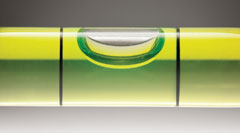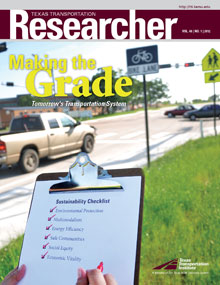
Transportation and Sustainability in the 21st Century
Nothing lasts forever.
For researchers in transportation, that particular cliché presents a challenge. If nothing lasts forever, how can we build a better, more efficient, longer-lasting network? Bang for the buck. More from less. As stakeholders in transportation, you no doubt know these phrases by heart.
The key to sustainability in transportation is balance. We have to maintain the system we’ve inherited by getting the most out of it, while also planning improvements that meet future needs: for example, population growth, urban development and market-driven changes in how we get goods to store shelves.
In this issue of the Texas Transportation Researcher, we feature a recent project conducted for the National Cooperative Highway Research Program. Texas Transportation Institute (TTI) researchers developed A Guidebook for Sustainability Performance Measurement for Transportation Agencies, which offers transportation agencies easy-to-use tools for continuously integrating sustainability into current agency policies. The guide encourages the use of performance measures to help tweak improvements to the transportation system over time, thereby extending its life.
Monitoring how we impact the environment is a principle of sustainability. For example, TTI researchers recently assessed the impact of increases in energy-related activities in Texas — from the development of wind farms to increased heavy-truck traffic from oil and gas sites — and developed geodatabases for the Texas Department of Transportation to use in avoiding potential maintenance problems before they arise.
 Making bicycle and pedestrian travel more feasible is part of creating an environmentally sustainable transportation network, and TTI’s recent work in this area is profiled in these pages. Likewise, decreasing traffic congestion, and thereby pollution, is also important, and our research into using global positioning system and Bluetooth devices to monitor traffic flow will help advance that cause (see related story).
Making bicycle and pedestrian travel more feasible is part of creating an environmentally sustainable transportation network, and TTI’s recent work in this area is profiled in these pages. Likewise, decreasing traffic congestion, and thereby pollution, is also important, and our research into using global positioning system and Bluetooth devices to monitor traffic flow will help advance that cause (see related story).
Sometimes the best of intentions to help the environment — like reusing recycled materials — can have unintended consequences. Such is the case with recycled glass used to improve pavement marking retroreflectivity, an essential property for helping keep drivers safe at night. Turns out, arsenic in the recycled glass beads can leach into the water table, causing an environmental hazard. Using equipment in TTI’s Visibility Laboratory, researchers are assessing the scope of this problem for the Federal Highway Administration.
And, last but not least, TTI Assistant Agency Director Steve Roop is currently developing the Freight Shuttle System, a revolutionary, safe and ecologically sustainable way to move freight from point A to point B without needing gasoline, increasing traffic congestion, or adding to roadway maintenance costs. The environmental benefits of this system are profiled here.
Another old saying might be appropriate in summing up the need for sustainability in our transportation network: “It’s not having what you want; it’s wanting what you have.” Research at TTI is making what we have in our transportation system more useful, more attractive and more sustainable. Because nothing lasts — well, you know.
